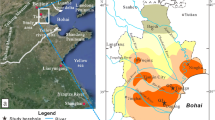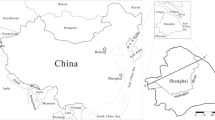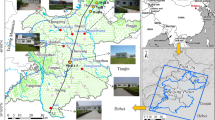Abstract
The plain of Beijing city in China suffers severe land subsidence owing to groundwater overdraft. The maximum subsidence rate could reach 6 cm/year through the 2000s. An integrated subsidence-monitoring program was designed, including levelling survey, borehole extensometers and multilayer monitoring of groundwater level, with the aim to understand both hydrological and mechanical processes and to characterize the land subsidence. From multilayer compaction monitoring, the major compression layers were identified. The major strata contributing to compression deformation are the second (64.5–82.3 m) and third (102–117 m) aquitards, which contributed around 39 % of the total subsidence. Meanwhile, irrecoverable deformations were also observed in the second (82.3–102 m) and third (117–148 m) confined aquifers; they exhibit elasto-plastic mechanical behavior, which is attributed to the thin beds of silt or silty clay. Stress–strain analysis and oedometer tests were conducted to study the aquifer-system response to pumping and to estimate the specific storage of the major hydrogeologic units. The results reveal the creep behavior and elasto-plastic, visco-elasto-plastic mechanical behavior of the aquitards at different depths. The compressibility of the aquitards in the inelastic range is about one order of magnitude larger than for the elastic range.
Résumé
La plaine de Pékin en Chine est sujette à des affaissements de terrain importants suite aux prélèvements d’eaux souterraines. La subsidence maximale pourrait avoir atteint 6 centimètres/an durant le 2000 è siècle. Un programme de contrôle de la subsidence a été élaboré comprenant une campagne de nivellement, extensiomètries en forage et un suivi multicouche des niveaux d’eau souterraine dans le but de comprendre à la fois les processus hydrologiques et mécaniques et de caractériser la subsidence des terrains. Les couches de plus grande compression ont été identifiées par un monitoring multicouche de compaction. Les couches principales qui contribuent à la compression des formations sont les deuxième (64.5–82.3 m) et troisième aquitards (102–117 m) qui contribuent pour environ 39 % de la subsidence totale. En même temps des déformations irréversibles ont été aussi observées dans les deuxième (82.3–102 m) et troisième (117–148 m) aquifères captifs; ils montrent un comportement mécanique élasto-plastique attribué aux fins lits de silt ou d’argile silteuse. Une analyse des contraintes et un test œdométrique ont été réalisés pour étudier la réponse du système aquifère aux pompages et estimer le coefficient d’emmagasinement spécifique des principales unités hydrogéologiques. Les résultats indiquent un comportement de fluage et un comportement mécanique élasto-plastique et visco-élasto-plastique des aquitards à différentes profondeurs. La compressibilité des aquitards dans la gamme non élastique est en amplitude d’un ordre de grandeur plus important que celle de la gamme élastique.
Resumen
La planicie de la ciudad de Beijing en China sufre una severa subsidencia del terreno debido a la sobreexplotación de agua subterránea. El máximo ritmo de subsidencia puede alcanzar 6 cm/año a través de los 2000. Se diseñó un programa integrado de monitoreo de la subsidencia, incluyendo relevamiento de niveles, extensómetros en perforaciones y monitoreo multicapa de niveles de agua subterránea, con el objetivo de entender los procesos hidrológicos y mecánicos y caracterizar la subsidencia del terreno. A partir del monitoreo de la compactación multicapa, se identificaron las principales capas de compresión. Las principales deformaciones del estrato que contribuyen a la compresión son los acuitardos segundo (64.5–82.3 m) y tercero (102–117 m), los cuales contribuyen en alrededor del 39 % de la subsidencia total. Mientras tanto, deformaciones irrecuperables fueron también observadas en los acuíferos confinados segundo (82.3–102 m) y tercero (117–148 m); ellos exhiben un comportamiento mecánico elasto plástico, el cual es atribuido a las delgadas capas de limos y de arcillas limosas. Se llevaron a cabo análisis de la tensión de deformación y los tests de odómetros para estudiar la respuesta del sistema acuífero al bombeo y estimar el almacenamiento específico de las principales unidades hidrogeológicas. Los resultados revelaron que el escurrimiento y el comportamiento mecánico elasto plastico visco elasto plastico de los acuitardos a diferentes profundidades. La compresibilidad de los acuitardos en el rango inelástico es alrededor de un orden de magnitud mayor que para el rango elástico.
摘要
过量开采地下水使得北京市平原区遭受了严重的地面沉降问题。2000年以来,最大的年沉降速率可达到6厘米/年。北京平原区建立了包括水准测量、分层标、分层地下水监测在内的监测体系,用于掌握含水层系统水、力过程及沉降特征。分层监测结果表明第二弱透水层(64.5–82.3 m)和第三弱透水层(102–117 m)是主要压缩层,约占总沉降量的39%左右。与此同时,在第二(82.3–102 m)、第三承压含水层(117–148 m)中也存在着不可恢复的形变,体现出弹塑性形变特征,这主要是由于含水层中包含着薄的粉土、粉质粘土夹层。本次采用应力-应变分析方法和土工实验手段相结合,研究含水层系统响应特征,评估主要水文地质单元的贮水能力。结果揭示了不同深度的弱透水层呈现出弹性、弹塑性和黏弹塑性复杂的力学行为。同时发现,弱透水层在非弹性阶段的压缩能力比弹性压缩阶段大一个数量级左右。
Resumo
A planície da cidade de Pequim, na China, sofre de subsidência severa, devido à extração de água subterrânea. A taxa máxima de subsidência pôde atingir os 6 cm/ano durante o ano 2000. Foi criado um programa integrado de monitorização da subsidência, que incluiu pesquisa de nivelamento, extensómetros em furos e monitorização multinível dos níveis da água subterrânea, com o objetivo de entender ambos os processos hidrológicos e mecânicos e de caraterizar a subsidência dos terrenos. A partir de monitorização compacta multinível, foram identificadas as camadas mais compressíveis. Os estratos principais que contribuem para a deformação por compressão são os segundo (64.5–82.3 m) e terceiro (102–117 m) aquitardos, os quais contribuem com cerca de 39 % da subsidência total. Entretanto, deformações irrecuperáveis foram também observadas nos segundo (82.3–102 m) e terceiro (117–148 m) aquíferos confinados; estes exibem um comportamento mecânico elasto-plástico, o qual é atribuído às finas camadas de silte ou argila siltosa. Foram realizados testes de análise tensão-deformação e de edómetro para estudar a resposta do sistema aquífero e estimar o armazenamento específico das principais unidades hidrogeológicas. Os resultados mostram o comportamento de fluência e o comportamento mecânico elasto-plástico e visco-elasto-plástico dos aquitardos a diferentes profundidades. A compressibilidade dos aquitardos na gama não elástica é cerca de uma ordem de magnitude maior do que na gama elástica.

















Similar content being viewed by others
References
Anderssohn J, Wetzel H-U, Walter TR et al (2008) Land subsidence pattern controlled by old alpine basement faults in the Kashmar Valley, northeast Iran: results from InSAR and levelling. Geophys J Int 174:287–294. doi:10.1111/j.1365-246X.2008.03805.x
Bin D (1964) Beijing hydrogeology survey report. First Hydrology Institute 0–96, Chinese Geological Survey, Beijing
Burbey TJ (2001) Stress–strain analyses for aquifer-system characterization. Ground Water 39:128–136. doi:10.1111/j.1745-6584.2001.tb00358.x
Casagrande A (1936) The determination of the pre-consolidation load and its practical significance. Proceedings of the International Conference on Soil Mech and Found Eng (ICSMFE) Cambridge, MA, 22–26 June 1936, vol 3. Harvard University, Cambridge, MA, pp 60–64
Epstein VJ (1987) Hydrologic and geologic factors affecting land subsidence near Eloy, Arizona. US Geol Surv Water Resour Invest Rep 87–4143. http://pubs.usgs.gov/wri/1987/4143/report.pdf. Accessed 7 July 2013
Galloway DL, Burbey TJ (2011) Review: regional land subsidence accompanying groundwater extraction. Hydrogeol J 19:1459–1486. doi:10.1007/s10040-011-0775-5
Galloway D, Jones DR, Ingebritsen SE (1999) Land subsidence in the United States. US Geol Surv Circ 1182. http://pubs.usgs.gov/circ/circ1182/pdf/circ1182_intro.pdf. Accessed 7 July 2013
Gambolati G, Teatini P, Baú D et al (2000) Importance of poroelastic coupling in dynamically active aquifers of the Po River Basin, Italy. Water Resour Res 36:2443–2459. doi:10.1029/2000wr900127
Hanson RT (1989) Aquifer-system compaction, Tucson Basin and Avra Valley, Arizona. US Geol Surv Water Resour Invest Rep 88–4172. http://pubs.usgs.gov/wri/1988/4172/report.pdf. Accessed 7 July 2013
Helm DC (1975) One-dimensional simulation of aquifer system compaction near Pixley, California: 1. constant parameters. Water Resour Res 11:465–478. doi:10.1029/WR011i003p00465
Helm DC (1976) One-dimensional simulation of aquifer system compaction near Pixley, California: 2. stress-dependent parameters. Water Resour Res 12:375–391. doi:10.1029/WR012i003p00375
Helm D (1998) Poroviscosity in land subsidence case histories and current research: Proceedings of the Dr. J.F. Poland Symposium on Land Subsidence: Special Publication No. 8, Assoc. of Eng. Geologists, Washington, DC
Ireland RL, Poland JF, Riley FS (1980) Land subsidence in the San Joaquin Valley, California, as of 1980. US Geol Surv Prof Pap 437-I. http://www.calwater.ca.gov/Admin_Record/C-040893.pdf. Accessed 7 July 2013
Jackson J, Helm D, Brumley J (2004) The role of poroviscosity in evaluating land subsidence due to groundwater extraction from sedimentary basin sequences. Geofis Int 43(4):689–695
Jia SM, Guo M, Ye C et al (2004) Investigation of land subsidence in Beijing. Beijing Institute of Hydrogeology and Engineering Geology, Beijing, pp 0–212
Li J, Helm D (1995) A general formulation for saturated aquifer deformation under dynamic and viscous conditions. Proceedings of the Fifth International Symposium on Land Subsidence, Hague, Netherlands, October 1995. IAHS Publ. 234, pp 323–332. http://ks360352.kimsufi.com/redbooks/a234/iahs_234_0323.pdf. Accessed 7 July 2013
Li J, Helm D (1997) Numerical formulation of dynamic behavior within saturated soil characterized by elasto-viscous behavior with an application to Las Vegas Valley. In: Yuan J (ed) Computer method and advances in geomechanics. Proceedings of the 9th International Conference of the International Association for Computer Method and Advances in Geomechanics, vol 2. Wuhan, China, Balkema, Amsterdam, pp 911–916
Liu C-H, Pan Y-W, Liao J-J et al (2004) Characterization of land subsidence in the Choshui River alluvial fan, Taiwan. Environ Geol 45:1154–1166. doi:10.1007/s00254-004-0983-6
Lofgen BE (1969) Field measurement of aquifer-system compaction, San Joaquin Valley, California, USA. In: Tison LJ (ed) Land subsidence. Proceedings of the Tokyo Symposium, Sept 1969, IAHS Publ. 88, pp 272–284 http://iahs.info/redbooks/a088/088031.pdf. Accessed 7 July 2013
Men F (1999a) Preliminary investigations on rheological properties of clay and ground settlement in Shanghai City (I) (in Chinese). J Nat Disasters 8:117–126
Men F (1999b) Preliminary investigations on rheological properties of clay and ground settlement in Shanghai City (II) (in Chinese). J Nat Disasters 8:123–132
Poland J, Davis G (1969) Land subsidence due to withdrawal of fluids. Rev Eng Geol 2:187–269
Pope JP, Burbey TJ (2004) Multiple-aquifer characterization from single borehole extensometer records. Ground Water 42:45–58
Riley FS (1970) Analysis of borehole extensometer data from central California. In: Tison LJ (ed) Land subsidence. Proceedings of the Tokyo Symposium, Sept 1969, IAHS Publ. 88, pp 423–431. http://aquadoc.typepad.com/files/088031.pdf. Accessed 7 July 2013
Riley FS (1984) Developments in borehole extensometry. In: Johnson AI, Carbognin L, Ubertini L (eds) Land subsidence. Proceedings of the Third International Symposium on Land Subsidence, Venice, Italy, March 1984, IAHS Publ. 151, pp 169–186. http://iahs.info/redbooks/a151/iahs_151_0169.pdf. Accessed 7 July 2013
Shi X, Xue Y, Wu J et al (2007) Characterization of regional land subsidence in Yangtze Delta, China: the example of Su-Xi-Chang area and the city of Shanghai. Hydrogeol J 16:593–607. doi:10.1007/s10040-007-0237-2
Sneed M (2001) Hydraulic and mechanical properties affecting ground-water flow and aquifer-system compaction, San Joaquin Valley, California. US Geol Surv Open-File Rep 01–35. http://pubs.usgs.gov/of/2001/ofr01-35/pdf/p1-4.pdf. Accessed 7 July 2013
Sneed M, Galloway DL (2000) Aquifer-system compaction: analyses and simulations—the Holly site. Edwards Air Force Base, Antelope Valley, California. US Geol Surv Water Resour Invest Rep 00–4015. http://pubs.usgs.gov/wri/2000/wri004015/pdf/wrir004015.pdf. Accessed 7 July 2013
Syvitski JPM, Kettner AJ, Overeem I et al (2009) Sinking deltas due to human activities. Nat Geosci 2:681–686. doi:10.1038/ngeo629
Terzaghi K (1925) Settlement and consolidation of clay. Engineering News-Record, 26 Nov 1925, pp 874–878
Xie Z, Wang Y, Zhang S (2003) Investigation and evaluation of groundwater resource and water environment around the capital area. Beijing Institute of Geological Survey, Beijing, 244 pp
Zhang Y, Xue Y-Q, Wu J-C et al (2007) Stress–strain measurements of deforming aquifer systems that underlie Shanghai, China. Environ Eng Geosci 8:217–228
Acknowledgements
The authors appreciate helpful review comments and suggestions on this article provided by Thomas Burbey, Devin Galloway and an anonymous reviewer, which greatly improved the quality of manuscript. Draft versions of the manuscript were reviewed by John Hess and Meijing Zhang. This research was partially supported by the Beijing Institute of Hydrogeology and Engineering Geology. The authors appreciate the assistance of Ye Chao, Liu Jiurong, Jia Sanman and Shen Yuanyuan who provided the water-level data and borehole extensometer data. This report is funded by the National Nature Science Foundation of China grant Nos. 41201376, 41130744, 41171335, Beijing Natural Science Foundation (No. 8133050, KZ201010028030), National Basic Research Program (973) of China (2006CB504400) and program (BJYRS-ZT-01-01).
Author information
Authors and Affiliations
Corresponding author
Rights and permissions
About this article
Cite this article
Zhang, Y., Gong, H., Gu, Z. et al. Characterization of land subsidence induced by groundwater withdrawals in the plain of Beijing city, China. Hydrogeol J 22, 397–409 (2014). https://doi.org/10.1007/s10040-013-1069-x
Received:
Accepted:
Published:
Issue Date:
DOI: https://doi.org/10.1007/s10040-013-1069-x




